

![]()
 (from
K is for KIWI, Reed)
(from
K is for KIWI, Reed)
'Oh, Aotearoa,' said the Albatross one day, 'will you fly away with me across the sea? We could find a place that suits us, and then maybe settle down, in the middle of an ocean, and beneath a long white cloud. All the Albatross' could make their homes upon your southern shore, while you, Aotearoa, could rest awhile upon the ocean floor.'
|
SCROLL DOWN TO FIND THE FOLLOWING COASTAL BIRDS:
FIORDLAND CRESTED & YELLOW EYED PENGUINS; BLUE & WHITE FLIPPERED PENGUINS; ROCKHOPPER & ROYAL PENGUINS; POMARINE & ARCTIC SKUA: SOUTHERN SKUA: ROYAL ALBATROSS. |
![]()
FIORDLAND CRESTED & YELLOW EYED PENGUIN / Hoiho
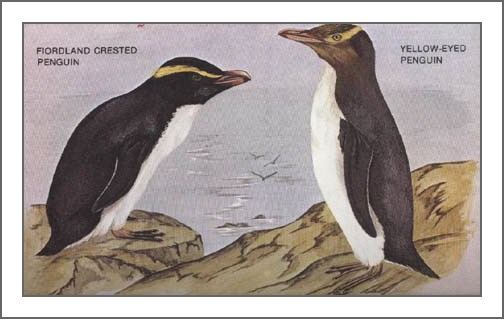
Fiordland Crested Penguin Eudyptes pachyrhynchus FAMILY: Spheniscidae Endemic to NZ and Fully protected. There are 3 closely related sub-species. This penguin has a strongly hooked heavy bill and a yellow stripe above the eye which extends backwards into separate crests. The white bases to the cheek feathers are obvious when the bird is excited. The immature birds have a white throat and little or no crest. Found in Sth Westland, Fiordland and Stewart Island in coastal native bush. They feed on small fish, squid and krill. Breeding is from July to September and the nest is of sticks and leaves, in scattered colonies among rocks or in caves and holes beneath tree roots. The eggs, 1-2, are white.
![]()
Yellow-eyed Penguin Megadyptes antipodes FAMILY: Sphenescidae
Endemic and fully protected. This is the largest of the New Zealand mainland penguins. The adult has a yellow eye and yellow band all round the head. The immature have a grey eye and no yellow band. Found on the eastern coast of the South Island of New Zealand, and on the sub-Antarctic Islands of Auckland and Campbell.
The yellow-eyed penguin is one of the world’s rarest penguins. They nest hidden from each other. Breeding is from September to February, and their nest of sticks and coarse grasses are usually found in scrubland and coastal bush, sometimes up to a kilometer inland. The eggs, 2, are white.
![]()
BLUE PENGUIN / Korora & WHITE FLIPPERED PENGUIN
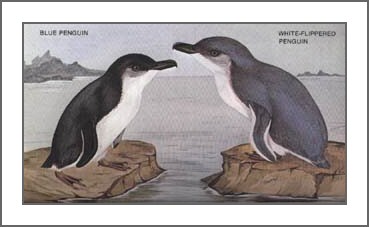
Blue Penguin Eudyptula minor FAMILY: Spheniscidae Native to NZ with several closely related sub-species in NZ. They also occur in Southern Australia from Perth to Sydney and Tasmania. Fully protected. This is the smallest of all penguins, with variable shades of blue on the back and white below. Except when breeding they spend their days at sea, and are nocturnal on land. The males have heavier bills than the females and their call is a long wail of varying pitch. They are plentiful around NZ coasts and feed mainly on small fish and fish larvae. Breeding is from August to November. The nest, of grasses and sticks can be found in caves, crevises, self-dug burrows under tree stumps, small bushes, under boulders and flax up to 1000ft. They will even nest under houses and in sheds. The eggs, 1-2, are white.
![]()
White -flippered Penguin Eudyptula albosignata FAMILY: Spheniscidae Endemic and fully protected. This bird is larger and lighter in colour than the Blue Penguin, with a white front edge to the flippers and a variable ammount of white on the tail and rump. They are plentiful on the Banks Peninsula and Canterbury coast, straggling to Cook Strait in the North and Otago Peninsula in the South. Habitat and food are the same as the Blue Penguin. Breeding is from August to November and the nest and eggs are similar to the Blue Penguin.
![]()
ROCKHOPPER & ROYAL PENGUIN
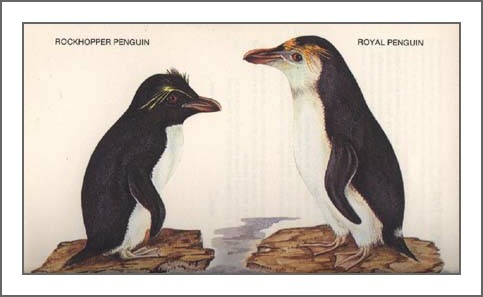
Rock-hopper Penguin Eudyptes crestatus FAMILY: Speniscidae Native to NZ . Circumpolar in the Southern Hemisphere with several sub-species. Fully protected. This is the smallest of the crested penguins, with ruby-red eyes and drooping yellow crests. The immature has a white chin and throat with little or no crests. They breed on sub-antarctic islands, the Snares, and straggling to NZ coasts. Food consists of fish and crustacea. Breeding is from October to December and the nest is a shallow depression in dense colonies among boulders and rocks. The eggs, 1-2, are white, but are soon covered with layers of mud.
![]()
Royal Penguin Eudyptes chrysolophus FAMILY: Speniscidae A visitor to NZ shores from the Macquarie Island race of the circumpolar Macaroni Penguin. Fully protected. This is the largest of the crested penguins, with a prominent heavy bill, white cheeks and throat, orange-gold forehead and long floppy crests. The immature do not have the crests. They breed in the open up to 150mt on Macquarie Island and sometimes visit NZ's southern coasts and sub-antarctic islands, to moult. They feed on crustacea. Breeding is from October to November and the nest is a shallow depression in very large colonies; in the open on flat or rolling ground. The eggs, 1-2, are white.
![]()
POMARINE & ARCTIC SKUA
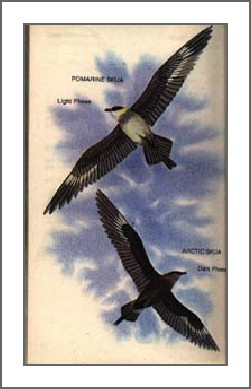
Pomarine Skua Stercorarius pomarinus FAMILY: Stercorariidae Migrant from arctic regions. Fully protected. Slightly larger than the Arctic Skua with more white on the underwing. Two plumage phases with either brown or light coloured underbody. They have prominent central tail feather which appear only in April, which are round ended and twisted. The immature bird is brown with light mottling and no long tail feathers. Flight is usually steady and graceful, but is hawk-like when chasing prey. They are a Summer visitor from November to April, and are seen in coastal waters and harbours from North Cape to Foveaux Strait, more plentiful in the North. They are scavengers and pirates near land, chasing gulls, terns and even gannets. Much of their food is obtained by chasing birds until they disgorge food, which is then caught by the Skua in the air. Breeding is from June to July, and the nest is a depression in low vegetation, sparsely lined with grass and lichens. The eggs, 2, are brownish-olive with brown spots.
![]()
Arctic Skua Stercorarius parasiticus FAMILY: tercorariidae Migrant from arctic regions. Fully protected. Slightly smaller than the Pomarine Skua, with less white on the underwing. Two plumage phases, either brown or light coloured underbody. The prominent sharply pointed central tail feathers appear in April. Habitat, distribution and breeding is the same as the Pomarine Skua, with the Arctic Skua's eggs, 2, coloured green or dark brown, either plain or spotted and blotched with dark brown.
![]()
SOUTHERN SKUA / Hakoakoa
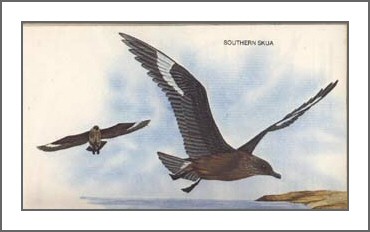
Southern Skua Stercorarius skua FAMILY: Stercorariidae Native, with several sub-species circumpolar in the Antarctic, sub-antarctic and North Atlantic. Partially protected. Larger than the Black-backed Gull, this bird is dark brown with conspicuous white patches on the wings. Very gull-like when in flight. They breed only on the mainland at Puysegur Point, and are plentiful at Stewart Island, sub-antarctic islands and north to the Chathams. They usually breed near petrel and penguin colonies, but in late Winter - June to August - they move away from islands and turn to scavenging at sea away from the mainland. They feed by scavenging on dead animal matter, young penguins and small live seabirds.
![]()
ROYAL ALBATROSS
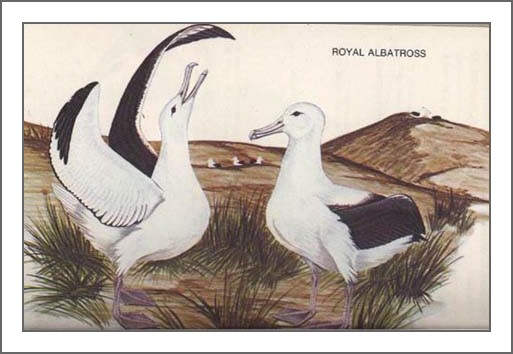
Royal Albatross Diomedea epomophora FAMILY: Diomedeidae Endemic to NZ, with 2 closely related sub-species. The northern race is shown in the picture. This is the largest flying bird, with a wingspan of up to 3mt. They are usually seen at sea and the male and female are alike. They breed on exposed and windy slopes or tops at Campbell and Auckland Islands (Southern race) and the Chatham Islands and Taiaroa Head, Dunedin, (Northern race). They can be seen breeding on the mainland at Taiaroa Head. They range throughout NZ seas when breeding and then disperse on a circumpolar movement in sub-antarctic waters. Food includes fish and squid. Breeding is from October to December and the chicks fly 8 months after hatching. The nest of grasses and other soft vegetation, is on the ground. The egg, 1, is white. Because incubation and rearing the chicks takes nearly 12 months, successful parents breed only every 2 years.

Copyright(c) 2006 Janet Marshall. All rights reserved.
myid@myhost.com
nbsp;


















